Python Programming ADP VTU CSE 18CS55 Module 3 Chapter 7 - A
2 likes587 views
║▌║▌▀Żs contain basics of python programming: Pattern Matching, Regular expression library, Basic RE Characters, RE methods, Programming examples and Demonstrations.
1 of 22

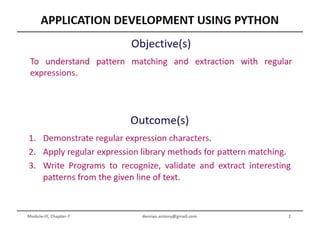



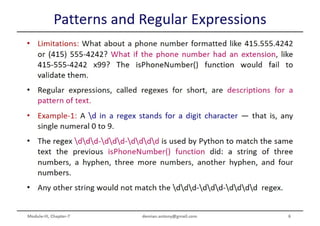
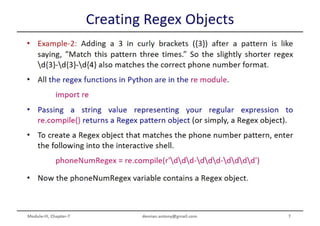
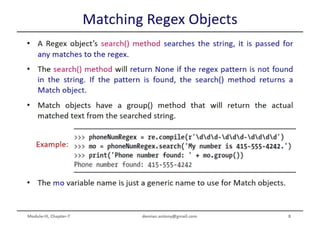

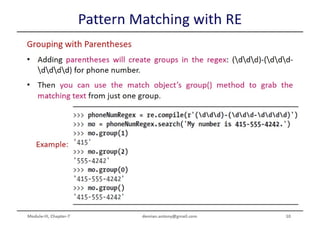
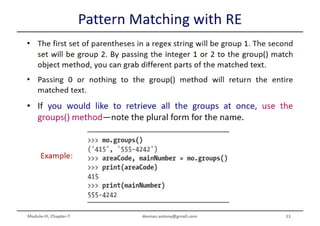


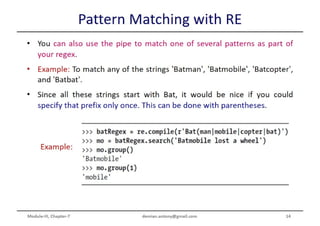
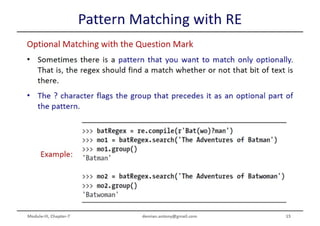
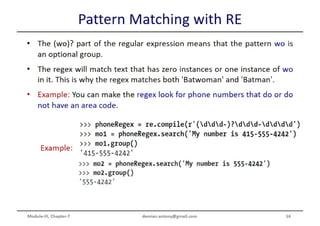



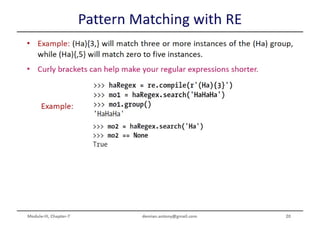
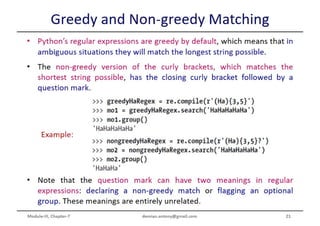

Recommended
Python Programming ADP VTU CSE 18CS55 Module 3 Chapter 7 - B



Python Programming ADP VTU CSE 18CS55 Module 3 Chapter 7 - BDemian Antony DMello
╠²
║▌║▌▀Żs contain basics of python programming: RE character classes, Methods, compile method options, Programming examples and Demonstrations.Python Programming ADP VTU CSE 18CS55 Module 5 Chapter 3



Python Programming ADP VTU CSE 18CS55 Module 5 Chapter 3Demian Antony DMello
╠²
The slides contain working with pdf and word documents in python, Programming examples and Demonstrations.Python Programming ADP VTU CSE 18CS55 Module 1 Chapter 1



Python Programming ADP VTU CSE 18CS55 Module 1 Chapter 1Demian Antony DMello
╠²
Python Basics and ProgrammingPython Programming ADP VTU CSE 18CS55 Module 2 Chapter 5



Python Programming ADP VTU CSE 18CS55 Module 2 Chapter 5Demian Antony DMello
╠²
Dictionary and Structuring Data with PythonPython Programming ADP VTU CSE 18CS55 Module 2 Chapter 6



Python Programming ADP VTU CSE 18CS55 Module 2 Chapter 6Demian Antony DMello
╠²
Manipulating Strings with PythonPython Programming ADP VTU CSE 18CS55 Module 3 Chapter 8 - B



Python Programming ADP VTU CSE 18CS55 Module 3 Chapter 8 - BDemian Antony DMello
╠²
║▌║▌▀Żs contain the basics of python programming: Files, Reading, Creating/Writing, Appending, Programming examples, and Demonstrations.Python Programming ADP VTU CSE 18CS55 Module 3 Chapter 8 - A



Python Programming ADP VTU CSE 18CS55 Module 3 Chapter 8 - ADemian Antony DMello
╠²
║▌║▌▀Żs contain basics of python programming: Files, Terminology, path, folders, traversal, Programming examples and Demonstrations.
Zagor Ludens 249 - Ratnice



Zagor Ludens 249 - RatniceStripovizijaStripovi
╠²
The document discusses the benefits of exercise for mental health. It notes that regular physical activity can help reduce anxiety and depression and improve mood and cognitive function. Exercise has also been shown to enhance self-esteem and serve as a healthy means of stress management.

Quran with Tajwid Surah 26 ’┤Šž¦┘ä┘éž▒žó┘å ž│┘łž▒█ā ž¦┘äž┤ž╣ž▒ž¦žĪ’┤┐ Ash-Shu'ara ¤Ö¬ PDF



Quran with Tajwid Surah 26 ’┤Šž¦┘ä┘éž▒žó┘å ž│┘łž▒█ā ž¦┘äž┤ž╣ž▒ž¦žĪ’┤┐ Ash-Shu'ara ¤Ö¬ PDFCaller To Islam / ž¦┘äž»ž¦ž╣┘Ŗž® ž¦┘äžźž│┘䞦┘ģ┘Ŗ
╠²
LIST OF SURAHS Ō¢║ https://plus.google.com/+CallertoislamTk-site/posts/eF8NukHeGDB

Data Types, Variables, and Arrays in JAVA



Data Types, Variables, and Arrays in JAVADemian Antony DMello
╠²
Lecture Notes
Module-1, Chapter-2
Data Types, Variables, and Arrays
Programme: B E (CSE)
Semester: 3
Course Code: BCS306A
Course Instructor: Demian Antony Dmello
2022 Scheme of VTU
An Overview of Java: Object-Oriented Programming (Two Paradigms, Abstraction, The Three OOP Principles), Using Blocks of Code, Lexical Issues (Whitespace, Identifiers, Literals, Comments, Separators, The Java Keywords).
Data Types, Variables, and Arrays: The Primitive Types (Integers, Floating-Point Types, Characters, Booleans), Variables, Type Conversion and Casting, Automatic Type Promotion in Expressions, Arrays, Introducing Type Inference with Local Variables.
Operators: Arithmetic Operators, Relational Operators, Boolean Logical Operators, The Assignment Operator, The ? Operator, Operator Precedence, Using Parentheses.
Control Statements: JavaŌĆÖs Selection Statements (if, The Traditional switch), Iteration Statements (while, do-while, for, The For-Each Version of the for Loop, Local Variable Type Inference in a for Loop, Nested Loops), Jump Statements (Using break, Using continue, return).
An Overview of Java; Data Types, Variables and Arrays; Operators; Control Statements.
Introducing Classes; Methods and Classes.
Inheritance; Interfaces.
Packages; Exceptions.
Multithreaded Programming; Enumerations, Type Wrappers and Autoboxing.006. ZAGOR - PODZEMLJE NJU ORLEANSA



006. ZAGOR - PODZEMLJE NJU ORLEANSATompa *
╠²
006. ZAGOR (VESELI ─īETVRTAK) - PODZEMLJE NJU ORLEANSA
006. ZAGOR - PODZEMLJE NJU ORLEANSA
006. ZAGOR - PODZEMLJE NJU ORLEANSA
006. ZAGOR - PODZEMLJE NJU ORLEANSA
006. ZAGOR - PODZEMLJE NJU ORLEANSA

0844. PLEME SAUKATompa *
╠²
El documento habla sobre la importancia de la educaci├│n y el aprendizaje continuo a lo largo de la vida. Se├▒ala que en un mundo en constante cambio es crucial que las personas sigan capacit├Īndose y actualizando sus conocimientos y habilidades para mantenerse relevantes. Tambi├®n enfatiza que tanto los individuos como las organizaciones deben comprender que el aprendizaje no termina una vez que se abandona la escuela, sino que es un proceso de por vida.Python Programming ADP VTU CSE 18CS55 Module 5 Chapter 4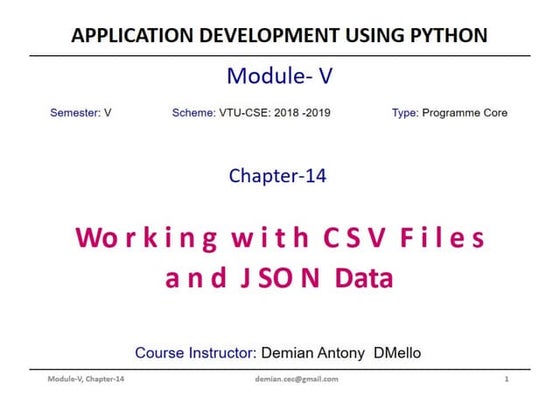



Python Programming ADP VTU CSE 18CS55 Module 5 Chapter 4Demian Antony DMello
╠²
The slides contain working with CSV and JSON documents in python, Programming examples and Demonstrations.Python Programming ADP VTU CSE 18CS55 Module 3 Chapter 9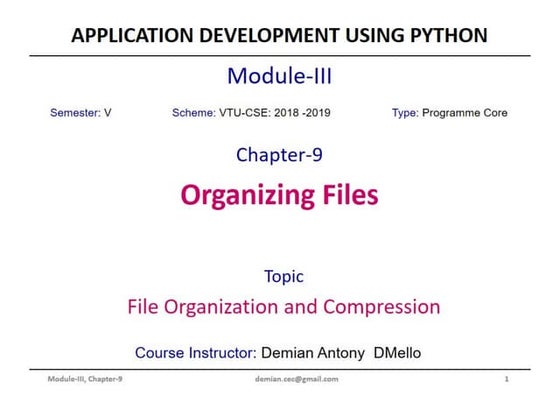



Python Programming ADP VTU CSE 18CS55 Module 3 Chapter 9Demian Antony DMello
╠²
║▌║▌▀Żs contain the basics of python programming: Files, Organizing files, copy, rename, move, delete files, Zip files, Programming examples, and Demonstrations.



Enumerations, Type Wrappers and Autoboxing



Enumerations, Type Wrappers and AutoboxingDemian Antony DMello
╠²
Lecture Notes
Module-5, Chapter-2
Enumerations, Type Wrappers and Autoboxing
Programme: B E (CSE)
Semester: 3
Course Code: BCS306A
Enumerations (Enumeration Fundamentals, The values() and valueOf() Methods), Type Wrappers (Character, Boolean, The Numeric Type Wrappers), Autoboxing (Autoboxing and Methods, Autoboxing/Unboxing Occurs in Expressions, Autoboxing/Unboxing Boolean and Character Values).Multithreaded Programming in JAVA



Multithreaded Programming in JAVADemian Antony DMello
╠²
Lecture Notes
Module-5, Chapter-1
Multithreaded Programming
Programme: B E (CSE)
Semester: 3
Course Code: BCS306A
The Java Thread Model, The Main Thread, Creating a Thread, Creating Multiple Threads, Using isAlive() and join(), Thread Priorities, Synchronization, Interthread Communication, Suspending, Resuming, and Stopping Threads, Obtaining a ThreadŌĆÖs State.More Related Content
What's hot (20)
Python Programming ADP VTU CSE 18CS55 Module 3 Chapter 8 - A



Python Programming ADP VTU CSE 18CS55 Module 3 Chapter 8 - ADemian Antony DMello
╠²
║▌║▌▀Żs contain basics of python programming: Files, Terminology, path, folders, traversal, Programming examples and Demonstrations.
Zagor Ludens 249 - Ratnice



Zagor Ludens 249 - RatniceStripovizijaStripovi
╠²
The document discusses the benefits of exercise for mental health. It notes that regular physical activity can help reduce anxiety and depression and improve mood and cognitive function. Exercise has also been shown to enhance self-esteem and serve as a healthy means of stress management.

Quran with Tajwid Surah 26 ’┤Šž¦┘ä┘éž▒žó┘å ž│┘łž▒█ā ž¦┘äž┤ž╣ž▒ž¦žĪ’┤┐ Ash-Shu'ara ¤Ö¬ PDF



Quran with Tajwid Surah 26 ’┤Šž¦┘ä┘éž▒žó┘å ž│┘łž▒█ā ž¦┘äž┤ž╣ž▒ž¦žĪ’┤┐ Ash-Shu'ara ¤Ö¬ PDFCaller To Islam / ž¦┘äž»ž¦ž╣┘Ŗž® ž¦┘äžźž│┘䞦┘ģ┘Ŗ
╠²
LIST OF SURAHS Ō¢║ https://plus.google.com/+CallertoislamTk-site/posts/eF8NukHeGDB

Data Types, Variables, and Arrays in JAVA



Data Types, Variables, and Arrays in JAVADemian Antony DMello
╠²
Lecture Notes
Module-1, Chapter-2
Data Types, Variables, and Arrays
Programme: B E (CSE)
Semester: 3
Course Code: BCS306A
Course Instructor: Demian Antony Dmello
2022 Scheme of VTU
An Overview of Java: Object-Oriented Programming (Two Paradigms, Abstraction, The Three OOP Principles), Using Blocks of Code, Lexical Issues (Whitespace, Identifiers, Literals, Comments, Separators, The Java Keywords).
Data Types, Variables, and Arrays: The Primitive Types (Integers, Floating-Point Types, Characters, Booleans), Variables, Type Conversion and Casting, Automatic Type Promotion in Expressions, Arrays, Introducing Type Inference with Local Variables.
Operators: Arithmetic Operators, Relational Operators, Boolean Logical Operators, The Assignment Operator, The ? Operator, Operator Precedence, Using Parentheses.
Control Statements: JavaŌĆÖs Selection Statements (if, The Traditional switch), Iteration Statements (while, do-while, for, The For-Each Version of the for Loop, Local Variable Type Inference in a for Loop, Nested Loops), Jump Statements (Using break, Using continue, return).
An Overview of Java; Data Types, Variables and Arrays; Operators; Control Statements.
Introducing Classes; Methods and Classes.
Inheritance; Interfaces.
Packages; Exceptions.
Multithreaded Programming; Enumerations, Type Wrappers and Autoboxing.006. ZAGOR - PODZEMLJE NJU ORLEANSA



006. ZAGOR - PODZEMLJE NJU ORLEANSATompa *
╠²
006. ZAGOR (VESELI ─īETVRTAK) - PODZEMLJE NJU ORLEANSA
006. ZAGOR - PODZEMLJE NJU ORLEANSA
006. ZAGOR - PODZEMLJE NJU ORLEANSA
006. ZAGOR - PODZEMLJE NJU ORLEANSA
006. ZAGOR - PODZEMLJE NJU ORLEANSA

0844. PLEME SAUKATompa *
╠²
El documento habla sobre la importancia de la educaci├│n y el aprendizaje continuo a lo largo de la vida. Se├▒ala que en un mundo en constante cambio es crucial que las personas sigan capacit├Īndose y actualizando sus conocimientos y habilidades para mantenerse relevantes. Tambi├®n enfatiza que tanto los individuos como las organizaciones deben comprender que el aprendizaje no termina una vez que se abandona la escuela, sino que es un proceso de por vida.Python Programming ADP VTU CSE 18CS55 Module 5 Chapter 4



Python Programming ADP VTU CSE 18CS55 Module 5 Chapter 4Demian Antony DMello
╠²
The slides contain working with CSV and JSON documents in python, Programming examples and Demonstrations.Python Programming ADP VTU CSE 18CS55 Module 3 Chapter 9



Python Programming ADP VTU CSE 18CS55 Module 3 Chapter 9Demian Antony DMello
╠²
║▌║▌▀Żs contain the basics of python programming: Files, Organizing files, copy, rename, move, delete files, Zip files, Programming examples, and Demonstrations.





Quran with Tajwid Surah 26 ’┤Šž¦┘ä┘éž▒žó┘å ž│┘łž▒█ā ž¦┘äž┤ž╣ž▒ž¦žĪ’┤┐ Ash-Shu'ara ¤Ö¬ PDF



Quran with Tajwid Surah 26 ’┤Šž¦┘ä┘éž▒žó┘å ž│┘łž▒█ā ž¦┘äž┤ž╣ž▒ž¦žĪ’┤┐ Ash-Shu'ara ¤Ö¬ PDFCaller To Islam / ž¦┘äž»ž¦ž╣┘Ŗž® ž¦┘äžźž│┘䞦┘ģ┘Ŗ
╠²








More from Demian Antony DMello (14)
Enumerations, Type Wrappers and Autoboxing



Enumerations, Type Wrappers and AutoboxingDemian Antony DMello
╠²
Lecture Notes
Module-5, Chapter-2
Enumerations, Type Wrappers and Autoboxing
Programme: B E (CSE)
Semester: 3
Course Code: BCS306A
Enumerations (Enumeration Fundamentals, The values() and valueOf() Methods), Type Wrappers (Character, Boolean, The Numeric Type Wrappers), Autoboxing (Autoboxing and Methods, Autoboxing/Unboxing Occurs in Expressions, Autoboxing/Unboxing Boolean and Character Values).Multithreaded Programming in JAVA



Multithreaded Programming in JAVADemian Antony DMello
╠²
Lecture Notes
Module-5, Chapter-1
Multithreaded Programming
Programme: B E (CSE)
Semester: 3
Course Code: BCS306A
The Java Thread Model, The Main Thread, Creating a Thread, Creating Multiple Threads, Using isAlive() and join(), Thread Priorities, Synchronization, Interthread Communication, Suspending, Resuming, and Stopping Threads, Obtaining a ThreadŌĆÖs State.Exception Handling in JAVA



Exception Handling in JAVADemian Antony DMello
╠²
Lecture Notes
Module-4, Chapter-2
Exception Handling
Programme: B E (CSE)
Semester: 3
Course Code: BCS306A
Course Instructor: Demian Antony Dmello
2022 Scheme of VTU
Exception-Handling Fundamentals, Exception Types, Uncaught Exceptions, Using try and catch, Multiple catch Clauses, Nested try Statements, throw, throws, finally, JavaŌĆÖs Built-in Exceptions, Creating Your Own Exception Subclasses, Chained Exceptions.Inheritance in JAVA



Inheritance in JAVADemian Antony DMello
╠²
Lecture Notes
Module-3, Chapter-1
Inheritance
Programme: B E (CSE)
Semester: 3
Course Code: BCS306A
Course Instructor: Demian Antony Dmello
2022 Scheme of VTU
Inheritance: Inheritance Basics, Using super, Creating a Multilevel Hierarchy, When Constructors Are Executed, Method Overriding, Dynamic Method Dispatch, Using Abstract Classes, Using final with Inheritance, Local Variable Type Inference and Inheritance, The Object Class.
Interfaces: Interfaces, Default Interface Methods, Use static Methods in an Interface, Private Interface Methods. Methods and Classes in JAVA



Methods and Classes in JAVADemian Antony DMello
╠²
Lecture Notes
Module-2, Chapter-2
Methods and Classes
Programme: B E (CSE)
Semester: 3
Course Code: BCS306A
Course Instructor: Demian Antony Dmello
2022 Scheme of VTU
Introducing Classes: Class Fundamentals, DeBCS306Aclaring Objects, Assigning Object Reference Variables, Introducing Methods, Constructors, The this Keyword, Garbage Collection.
Methods and Classes: Overloading Methods, Objects as Parameters, Argument Passing, Returning Objects, Recursion, Access Control, Understanding static, Introducing final, Introducing Nested and Inner Classes.Introducing Classes in JAVA



Introducing Classes in JAVADemian Antony DMello
╠²
Lecture Notes
Module-2, Chapter-1
Introducing Classes
Programme: B E (CSE)
Semester: 3
Course Code: BCS306A
Course Instructor: Demian Antony Dmello
2022 Scheme of VTU
Introducing Classes: Class Fundamentals, Declaring Objects, Assigning Object Reference Variables, Introducing Methods, Constructors, The this Keyword, Garbage Collection.
Methods and Classes: Overloading Methods, Objects as Parameters, Argument Passing, Returning Objects, Recursion, Access Control, Understanding static, Introducing final, Introducing Nested and Inner Classes.Control Statements in JAVA



Control Statements in JAVADemian Antony DMello
╠²
Lecture Notes
Module-1, Chapter-4
Control Statements
Programme: B E (CSE)
Semester: 3
Course Code: BCS306A
Course Instructor: Demian Antony Dmello
2022 Scheme of VTU
An Overview of Java: Object-Oriented Programming (Two Paradigms, Abstraction, The Three OOP Principles), Using Blocks of Code, Lexical Issues (Whitespace, Identifiers, Literals, CommAents, Separators, The Java Keywords).
Data Types, Variables, and Arrays: The Primitive Types (Integers, Floating-Point Types, Characters, Booleans), Variables, Type Conversion and Casting, Automatic Type Promotion in Expressions, Arrays, Introducing Type Inference with Local Variables.
Operators: Arithmetic Operators, Relational Operators, Boolean Logical Operators, The Assignment Operator, The ? Operator, Operator Precedence, Using Parentheses.
Control Statements: JavaŌĆÖs Selection Statements (if, The Traditional switch), Iteration Statements (while, do-while, for, The For-Each Version of the for Loop, Local Variable Type Inference in a for Loop, Nested Loops), Jump Statements (Using break, Using continue, return).
An Overview of Java; Data Types, Variables and Arrays; Operators; Control Statements.
Introducing Classes; Methods and Classes.
Inheritance; Interfaces.
Packages; Exceptions.
Multithreaded Programming; Enumerations, Type Wrappers and Autoboxing.Operators in JAVA



Operators in JAVADemian Antony DMello
╠²
Lecture Notes
Module-1, Chapter-3
Operators
Programme: B E (CSE)
Semester: 3
Course Code: BCS306A
Course Instructor: Demian Antony Dmello
2022 Scheme of VTU
An Overview of Java: Object-Oriented Programming (Two Paradigms, Abstraction, The Three OOP Principles), Using Blocks of Code, Lexical Issues (Whitespace, Identifiers, Literals, Comments, Separators, The Java Keywords).
Data Types, Variables, and Arrays: The Primitive Types (Integers, Floating-Point Types, Characters, Booleans), Variables, Type Conversion and Casting, Automatic Type Promotion in Expressions, Arrays, Introducing Type Inference with Local Variables.
Operators: Arithmetic Operators, Relational Operators, Boolean Logical Operators, The Assignment Operator, The ? Operator, Operator Precedence, Using Parentheses.
Control Statements: JavaŌĆÖs Selection Statements (if, The Traditional switch), Iteration Statements (while, do-while, for, The For-Each Version of the for Loop, Local Variable Type Inference in a for Loop, Nested Loops), Jump Statements (Using break, Using continue, return).
An Overview of Java; Data Types, Variables and Arrays; Operators; Control Statements.
Introducing Classes; Methods and Classes.
Inheritance; Interfaces.
Packages; Exceptions.
Multithreaded Programming; Enumerations, Type Wrappers and Autoboxing.Object Oriented Programming with JAVA



Object Oriented Programming with JAVADemian Antony DMello
╠²
Lecture Notes
Module-1, Chapter-1
An Overview of Java
Programme: B E (CSE)
Semester: 3
Course Code: BCS306A
Course Instructor: Demian Antony Dmello
2022 Scheme of VTU
An Overview of Java: Object-Oriented Programming (Two Paradigms, Abstraction, The Three OOP Principles), Using Blocks of Code, Lexical Issues (Whitespace, Identifiers, Literals, Comments, Separators, The Java Keywords).
Data Types, Variables, and Arrays: The Primitive Types (Integers, Floating-Point Types, Characters, Booleans), Variables, Type Conversion and Casting, Automatic Type Promotion in Expressions, Arrays, Introducing Type Inference with Local Variables.
Operators: Arithmetic Operators, Relational Operators, Boolean Logical Operators, The Assignment Operator, The ? Operator, Operator Precedence, Using Parentheses.
Control Statements: JavaŌĆÖs Selection Statements (if, The Traditional switch), Iteration Statements (while, do-while, for, The For-Each Version of the for Loop, Local Variable Type Inference in a for Loop, Nested Loops), Jump Statements (Using break, Using continue, return).
An Overview of Java; Data Types, Variables and Arrays; Operators; Control Statements.
Introducing Classes; Methods and Classes.
Inheritance; Interfaces.
Packages; Exceptions.
Multithreaded Programming; Enumerations, Type Wrappers and Autoboxing.
Textbook
Java: The Complete Reference, Twelfth Edition, by Herbert Schildt, November 2021, McGraw-Hill, ISBN: 9781260463422
References:
Programming with Java, 6th Edition, by E Balagurusamy, Mar-2019, McGraw Hill Education, ISBN: 9789353162337
Thinking in Java, Fourth Edition, by Bruce Eckel, Prentice Hall, 2006 (https://sd.blackball.lv/library/thinking_in_java_4th_edition.pdf)JAVA - VTU - Object oriented Concepts - 18CS45 - Module I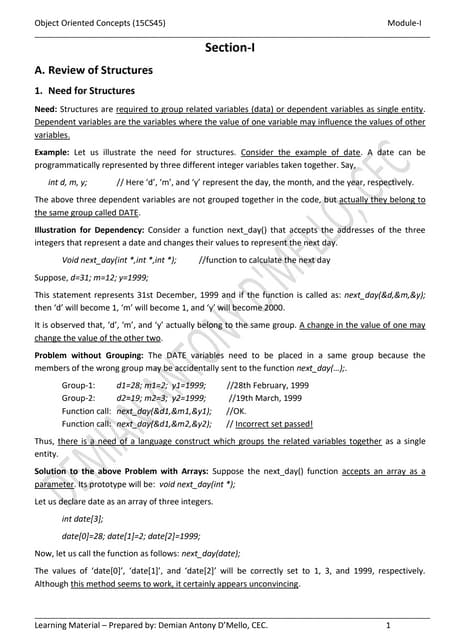



JAVA - VTU - Object oriented Concepts - 18CS45 - Module IDemian Antony DMello
╠²
This document discusses structures in C and C++ and how they are used to create user-defined data types. It explains that structures allow grouping of related variables together as a single entity. It describes the three-step process to create a new data type using structures: defining the structure in a header file, implementing associated functions in a source file, and providing the header and library to other programmers. It also compares procedure-oriented and object-oriented programming, noting that OOP allows associated functions exclusive access to structure variables to ensure data security. Console input/output in C++ is also summarized using objects like cout and cin along with insertion and extraction operators.Python Programming ADP VTU CSE 18CS55 Module 4 Chapter 3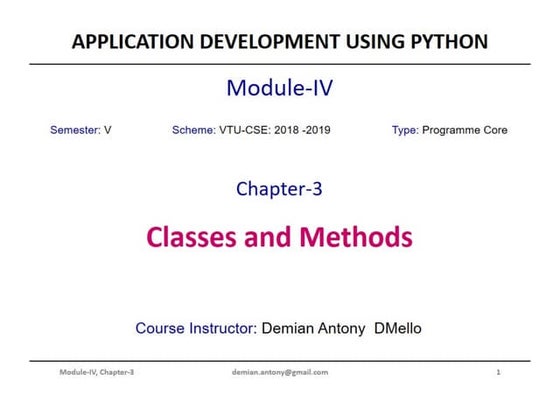



Python Programming ADP VTU CSE 18CS55 Module 4 Chapter 3Demian Antony DMello
╠²
The slides contain basics of python programming: int(), str(), prototype and patch, designed development, Programming examples and Demonstrations.Python Programming ADP VTU CSE 18CS55 Module 4 Chapter 1



Python Programming ADP VTU CSE 18CS55 Module 4 Chapter 1Demian Antony DMello
╠²
The slides contain basics of python programming: Classs, Objects, Attributes, methods, references, copy method, deepcopy method, Programming examples and Demonstrations.Python Programming ADP VTU CSE 18CS55 Module 4 Chapter 2



Python Programming ADP VTU CSE 18CS55 Module 4 Chapter 2Demian Antony DMello
╠²
The slides contain the basics of python programming: Classs, Objects, Pure functions, Modifiers, Prototype and patch, Designed Development, Programming examples, and Demonstrations.Research Paper Writing



Research Paper WritingDemian Antony DMello
╠²
The slides provide steps for writing structured Research Paper.Recently uploaded (20)
UHV UNIT-5 IMPLICATIONS OF THE ABOVE HOLISTIC UNDERSTANDING OF HARMONY ON ...



UHV UNIT-5 IMPLICATIONS OF THE ABOVE HOLISTIC UNDERSTANDING OF HARMONY ON ...ariomthermal2031
╠²
IMPLICATIONS OF THE ABOVE HOLISTIC UNDERSTANDING OF HARMONY ON PROFESSIONAL ETHICS LA11-Case study of motherboard and internal components of motheroard.docx



LA11-Case study of motherboard and internal components of motheroard.docxVidyaAshokNemade
╠²
Thisis case study of motherboard22PCOAM16 ML UNIT 2 NOTES & QB QUESTION WITH ANSWERS



22PCOAM16 ML UNIT 2 NOTES & QB QUESTION WITH ANSWERSGuru Nanak Technical Institutions
╠²
22PCOAM16 ML UNIT 2 NOTES & QB QUESTION WITH ANSWERS Explainability and Transparency in Artificial Intelligence: Ethical Imperativ...



Explainability and Transparency in Artificial Intelligence: Ethical Imperativ...AI Publications
╠²
Artificial Intelligence (AI) is increasingly embedded in high-stakes domains such as healthcare, finance, and law enforcement, where opaque decision-making raises significant ethical concerns. Among the core challenges in AI ethics are explainability and transparencyŌĆökey to fostering trust, accountability, and fairness in algorithmic systems. This review explores the ethical foundations of explainable AI (XAI), surveys leading technical approaches such as model-agnostic interpretability techniques and post-hoc explanation methods and examines their inherent limitations and trade-offs. A real-world case study from the healthcare sector highlights the critical consequences of deploying non-transparent AI models in clinical decision-making. The article also discusses emerging regulatory frameworks and underscores the need for interdisciplinary collaboration to address the evolving ethical landscape. The review concludes with recommendations for aligning technical innovation with ethical imperatives through responsible design and governance.Mastering Secure Login Mechanisms for React Apps.pdf



Mastering Secure Login Mechanisms for React Apps.pdfBrion Mario
╠²
How to securely add login to any React application.Supervised Learning Ensemble Techniques Machine Learning



Supervised Learning Ensemble Techniques Machine LearningShivarkarSandip
╠²
Supervised Learning Ensemble Techniques, Bagging-Random Forest trees, Voting types,Boosting -Ada boost, gradient boostingLA2-64 -bit assemby language program to count number of positive and negative...



LA2-64 -bit assemby language program to count number of positive and negative...VidyaAshokNemade
╠²
This is one of lab experiment for Microprocessor PROJECT REPORT ON PASTA MACHINE - KP AUTOMATIONS - PASTA MAKING MACHINE PROJE...



PROJECT REPORT ON PASTA MACHINE - KP AUTOMATIONS - PASTA MAKING MACHINE PROJE...yadavchandan322
╠²
All the materials and content contained in Project report is for educational purpose and reflect the views of the industry which are drawn from various research on pasta machine. PM FME- Detailed Project Report of Multigrain Pasta Making Unit. 3. 1. PROJECT ... A pasta extruder is a machine that makes pasta dough through dies to.The process is quite simple and requires not much skilled labour. The machine itself is high technology and provides the manufacturers to produce noodles with. In this article, you will be able to get all the detail about a pasta-making business unit in India and the financial status of this business as well.ENGINEERS INDIA RESEARCH INSTITUTE - Service Provider of Project Report on PASTA PRODUCTION PLANT (SHORT PASTA) [CODE NO. 1632] based in Delhi, India.
Macaroni Machines are used to produce pasta from the raw material. With ... The views expressed in this Project Report are advisory in nature. SAMADHAN.
Airport Components Part1 ppt.pptx-Site layout,RUNWAY,TAXIWAY,TAXILANE



Airport Components Part1 ppt.pptx-Site layout,RUNWAY,TAXIWAY,TAXILANEPriyanka Dange
╠²
RUNWAY,TAXIWAY,TAXILANEVirtual Power plants-Cleantech-Revolution



Virtual Power plants-Cleantech-RevolutionAshoka Saket
╠²
VPPs are virtual aggregations of distributed energy resources, such as energy storage, solar panels, and wind turbines, that can be controlled and optimized in real-time to provide grid services.applicationof differential equation.pptx



applicationof differential equation.pptxPPSTUDIES
╠²
irst-order differential equations find applications in modeling various phenomena, including growth and decay processes, Newton's law of cooling, electrical circuits, falling body problems, and mixing problems. 22PCOAM16 _ML_ Unit 2 Full unit notes.pdf



22PCOAM16 _ML_ Unit 2 Full unit notes.pdfGuru Nanak Technical Institutions
╠²
22 PCOAM16 _ML_ Unit 2 Full unit notes.pdfOptimize AI Latency & Response Time with LLumo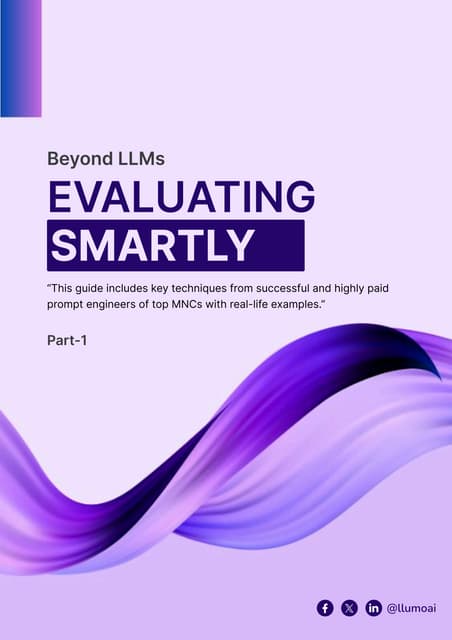



Optimize AI Latency & Response Time with LLumosgupta86
╠²
Long response times kill user experience. We provide real-time monitoring and optimizations to ensure fast, seamless interactions.Why the Engineering Model is Key to Successful Projects



Why the Engineering Model is Key to Successful ProjectsMaadhu Creatives-Model Making Company
╠²
In this PDF document, the importance of engineering models in successful project execution is discussed. It explains how these models enhance visualization, planning, and communication. Engineering models help identify potential issues early, reducing risks and costs. Ultimately, they improve collaboration and client satisfaction by providing a clear representation of the project.Knowledge-Based Agents in AI: Principles, Components, and Functionality



Knowledge-Based Agents in AI: Principles, Components, and FunctionalityRashmi Bhat
╠²
This PowerPoint presentation provides an in-depth exploration of Knowledge-Based Agents (KBAs) in Artificial Intelligence (AI). It explains how these agents make decisions using stored knowledge and logical reasoning rather than direct sensor input. The presentation covers key components such as the Knowledge Base (KB), Inference Engine, Perception, and Action Execution.
Key topics include:
Ō£ģ Definition and Working Mechanism of Knowledge-Based Agents
Ō£ģ The Process of TELL, ASK, and Execution in AI Agents
Ō£ģ Representation of Knowledge and Decision-Making Approaches
Ō£ģ Logical Inference and Rule-Based Reasoning
Ō£ģ Applications of Knowledge-Based Agents in Real-World AI
This PPT is useful for students, educators, and AI enthusiasts who want to understand how intelligent agents operate using stored knowledge and logic-based inference. The slides are well-structured with explanations, examples, and an easy-to-follow breakdown of AI agent functions.Water Industry Process Automation & Control Monthly - April 2025



Water Industry Process Automation & Control Monthly - April 2025Water Industry Process Automation & Control
╠²
Welcome to the April 2025 edition of WIPAC Monthly, the magazine brought to you by the LInkedIn Group Water Industry Process Automation & Control.
In this month's issue, along with all of the industries news we have a number of great articles for your edification
The first article is my annual piece looking behind the storm overflow numbers that are published each year to go into a bit more depth and look at what the numbers are actually saying.
The second article is a taster of what people will be seeing at the SWAN Annual Conference next month in Berlin and looks at the use of fibre-optic cable for leak detection and how its a technology we should be using more of
The third article, by Rob Stevens, looks at what the options are for the Continuous Water Quality Monitoring that the English Water Companies will be installing over the next year and the need to ensure that we install the right technology from the start.
Hope you enjoy the current edition,
OliverWater Industry Process Automation & Control Monthly - April 2025



Water Industry Process Automation & Control Monthly - April 2025Water Industry Process Automation & Control
╠²













